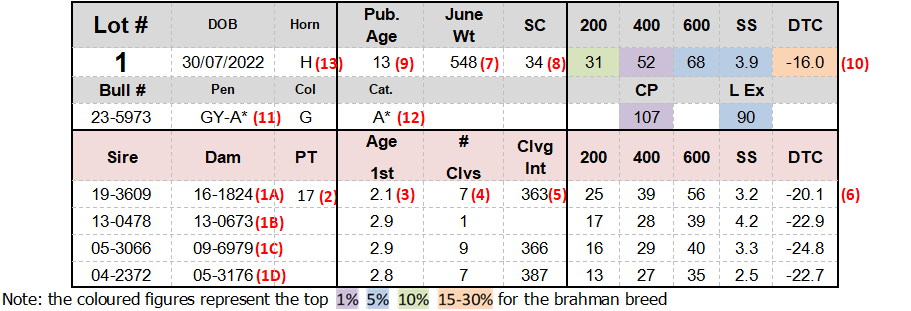How to read the ALC Bull Sale Catalogue
The principle of ALC genetics management is to report all data from our whole herd, to our clients and potential clients. Our aim is to have the most important data in nett commercial terms, readily available, in easy to read format. In most regions of the commercial beef-raising world the important profit index ranks as follows for every $10 margin:
- $7 earned by good reproduction
- $2 earned by live weight growth
- $1 earned by other traits (carcase, colour, temperament etc)
The ALC herd stems from four decades of intense selection in the traits of fertile, gentle and growthy cattle adapted to our Northern Australian costs and conditions. Four traits are plenty to select for.
- Fertility and adaptation may end up meaning the same thing.
- Good temperament is essential for low costs in labour and facilities, and minimising market losses.
- Growth usually equals consumption, so there is literally no free feed there, in normal Northern Australian conditions. The most elusive factor is adequate groceries for our herds. You can equate this in several ways, eg. stocking rates per square mile, stock days per hectare per 100mm of rain, or acres to the beast. All of these have an equivalent dollar cost, whether on your own country or on agistment. Quantity and distribution of rainfall has a big impact on our costs each year also.
So let’s focus on the real stuff.
Fertility and adaptation… we can use the simple fertility measures of pregnant or empty, and weaned a calf or lost a calf or pregnancy. This criteria of pregnant must fall in a set period, or we would be hiding behind excuses forever. Similarly, a weaner in the yard, or no weaner is pretty final judgement too. For every year of ownership, any less than a calf weaned plus a pregnancy is simply not an option. They are then proven adapted cows. We provide very transparent data on all Dams, Grand Dams, Great Grand Dams and Great Great Grand Dams of our ALC sale bulls.
- (1A) is the Dam, (1B) is the G.Dam, (1C) is the G.G.Dam and (1D) is the G.G.G.Dam of the sale bull.
- PT result in weeks from April 2024 pregnancy test.
- Age at first calf.
- Number of calves born.
- Subsequent calving interval in days.
- Days to Calving EBV (DTC) is an indicator of female fertility based on the time between a cow’s first exposure to a bull and when she subsequently calved.
- Kg live weight in June.
- Testicle scrotal circumference (SC) in June.
- Age in months at puberty.
- Estimated Breeding Values (EBV’s) for growth at 200, 400 and 600 days of age along with scrotal size (SS), days to calving (DTC), Central Production $ index (CP) and Live Ex. $ index (L Ex).
- Bulls are penned in groups of 15 to 20 head. Pens are labelled on the gates. For example, a grey A* sale bull marked Lot # 6 would be found in the pen labelled “PEN GY-A* LOTS 1-15”.
- Sale bulls are categorised as categories A and A*. Category A* being what we consider to be the lead of the sale bulls.
- The clean headed polled bulls were poll tested and verified as either (PP) Homozygous Poll or (P) Heterozygous Poll. The bulls that are marked as (S) for Scurred that were snipped at branding, have been poll tested and verified as Polled or Scurred. The bulls with buttons that are marked as (S) for Scurred, are a visual assessment only, they have not been verified with a test.
Production and genetic information for all sires is also provided. Almost all of this data is related to speed of production driven by reproduction indicators. ALC bulls are priced accordingly. Please contact us direct for further discussion and sale bull data.
